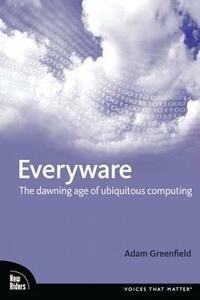Take a photo of a barcode or cover
Excellent discussion of the origins of ubiquitous computing, current state of the art (as of 2005), where it might be headed and potential issues and design principles. A must-read, not only in terms of ubiquitous computing, but as an examplar of writings on the social use of technology and as a source of potential design principles for Web 2.0 app developers.
This book has a strong focus on the human side of new-fangled technology, which makes it refreshingly different than most books about the subject.
The only thing I didn't like about this book is that the extremely short chapters made the book feel very long. It was almost like reading a series of blog posts about ubiquitous computing, though a series of very well written and carefully ordered blog posts.
As a designer, the last section was the most relevant and interesting, about the ways everyware should be designed to preserve our humanity in the face of technological change. Short answer: it shouldn't make our lives worse.
The only thing I didn't like about this book is that the extremely short chapters made the book feel very long. It was almost like reading a series of blog posts about ubiquitous computing, though a series of very well written and carefully ordered blog posts.
As a designer, the last section was the most relevant and interesting, about the ways everyware should be designed to preserve our humanity in the face of technological change. Short answer: it shouldn't make our lives worse.
Seems a curious mix of too-far-ahead and not-caught-up with today. Some good points overall but a little frustrating to read in the 'thesis' presentation.


